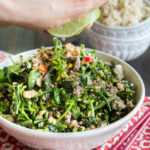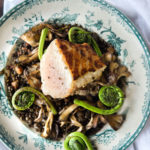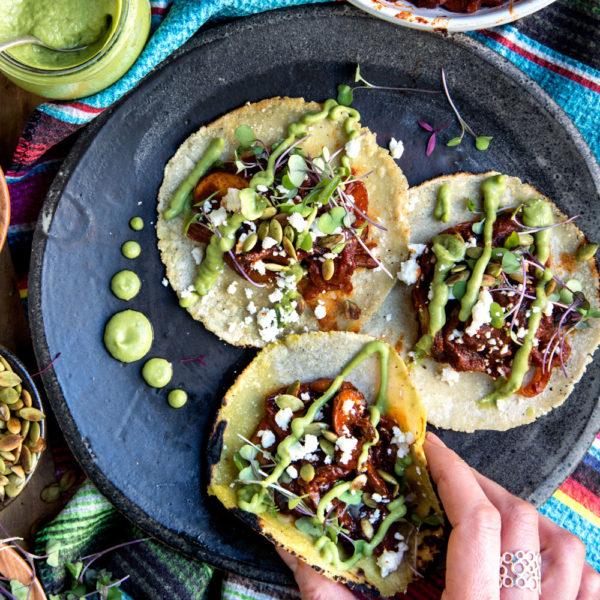I have a new love…
Amaranth, have you tried it? It’s a tiny, little, minuscule “pseudo-grain”with a lot of character and a robust nutritional profile. Find it in the bulk aisle at your local Whole Foods or, perhaps, other health food/natural grocery store.
I typically make a humble porridge out of it, along the lines of polenta. When cooked, amaranth takes on a creamy texture (in a fraction of the time it takes polenta to cook), with an earthy, nutty flavor. You can go sweet or savory with amaranth. I have a savory amaranth porridge in the works…but today decided to indulge my sweet side, with a chocolate amaranth beet cake. I typically don’t make a lot of desserts, but when I do, you can bet it will include dark chocolate in some way, shape, or form :-). There’s espresso in the cake too, my other love.
Chocolate Beet Amaranth Cake …
I’ve been wanting to make Nigel Slater’s chocolate beet cake ever since I purchased his lovely book, Tender: A cook and his vegetable patch. But my never ending list of dishes to prepare had put it on the back burner. Today, I finally took the plunge. Slater calls it a, “seductive cake, deeply moist and tempting” and I couldn’t agree more. In honor of my new found love, thought I’d put my own spin on things, utilizing amaranth flour in place of all-purpose flour.
Nigel recommends topping the beet cake with crème fraîche and poppy seeds. He writes, “The serving suggestion of crème fraîche is not just a nod to the sour cream so close to beets’ Eastern European heart, it is an important part of the cake.” While I initially resisted shelling out the extra cash, my curiosity got the better of me. And I must confess, he’s spot on! The crème fraîche adds that extra little something.
Grinding amaranth seeds to make flour…
Since I had a bunch of amaranth seeds on hand, decided to improvise a bit and make my own amaranth flour by popping the seeds in a hot pan (wok) to bring out its inherent nuttiness. It’s fun to watch the seeds pop all over the place, turning from their natural brownish color to white, like little firecrackers. Just make sure to pop in small batches otherwise the amaranth will burn. Once they get going, it takes just seconds, and then the “fireworks” are over.
After popping the amaranth, I ground the popped seeds in a spice grinder (since I don’t own a seed mill/grinder). I like the nutty notes amaranth imparts to the overall flavor of the cake/cupcakes as well.
A bit on amaranth…
Amaranth actually is not a “true” cereal grain like oats, wheat, and most other grains given that amaranth does not stem from the Poaceae family of plants. However, because of its overall nutrient profile is similar to that of cereals, amaranth has been lumped in with this group.
Amaranth has been utilized in traditional diets spanning thousands of years. However, unlike other grains, amaranth contains more than three times the average amount of calcium, and is also high in iron, magnesium, phosphorus, and potassium. It is also the only “grain” documented to contain Vitamin C. At about 13-14%, it easily surpasses the protein content of most other grains. The protein in amaranth is considered “complete” because it contains all essential amino acids (the building block of proteins), including lysine, an amino acid missing or negligible in many grains.
Amaranth’s unfortunate past…
Amaranth is thought to have been domesticated 6,000 to 8,000 years ago. Amaranth has long been eaten in Mexico and is considered a native crop of Peru. The Aztecs relied on amaranth as a food staple and used it in religious rituals, earning amaranth the names, “super grain of the Aztecs” and “golden grain of the gods.” However, when Cortez and his Spaniards landed in the New World in the sixteenth century, they outlawed such foods involved in religious festivals, as they set out to convert the Aztecs to Christianity. Amaranth crops were burned and possession of amaranth was cause for severe punishment.
Luckily, some seeds survived, and we are fortunate enough to continue to enjoy this super grain of the gods today (lets hope Monsanto doesn’t get their hands on it)!
Had just enough batter for a 9×5 loaf pan, and two extra cupcakes…
Chocolate Beet Amaranth Cake
Adapted from Tender, by Nigel Slater
8 ounces beets
8 ounces (between 70-75% cacao) dark chocolate, chopped into small pieces
4 tablespoons hot espresso
3/4 cup plus 2 tablespoons (200 grams) butter, cut into small pieces
1 cup plus 2 tablespoons (135 grams) amaranth flour
a heaping teaspoon baking powder
3 tablespoons good-quality cocoa powder
5 eggs
1 scant cup (coconut) sugar
Crème fraîche and poppy seeds to serve
Preheat the oven to 350 degrees.
Lightly butter a cake pan and line the bottom with parchment (you can use an 8-inch springform pan as he suggests, a 9×5 loaf pan, or even form into cupcakes).
Cook the beets, whole and unpeeled, in boiling water until fork tender, 30 to 40 minutes. Drain, cool, and peel (remove the stem and root). Process in a food processor or blender to a course puree.
Place the chopped chocolate in a heat-proof (metal) bowl, and place on a pot of simmering water. When the chocolate is nearly melted, add the hot espresso, then add the butter, let soften. Remove from the heat and stir until all ingredients are well combined.
Combine the flour, baking powder, and cocoa. Set aside.
Separate the eggs; the yolks in one bowl, the whites in another. Whisk the egg yolks. After the chocolate has sat for a few minutes, stir in the yolks and gently whisk to combine. Fold in the beets.
Whisk the egg whites until stiff. Fold in the sugar. Then, firmly but gently, fold the egg whites and sugar into the chocolate mixture (be careful not to overmix). Fold in the flour-cocoa mixture.
Transfer to the cake pan. Place in the oven, and turn the heat down to 325 degrees. Bake 40 minutes (the inner part of the cake will still be a bit wobbly). Let the cake cool, loosening the edges after a half hour or so. Serve with crème fraîche and poppy seeds.














6 comments
Happy Valley Chow
That sounds sooo good! I love the photography as well, great job 🙂
Happy Blogging!
Happy Valley Chow
Happy Valley Chow
That sounds sooo good! I love the photography as well, great job 🙂
Happy Blogging!
Happy Valley Chow
Trish
In my midwestern locale, a species of amaranth, waterhemp, is largely responsible for the success of Monsanto's roundup resistant soybean program. This weed was not controlled by the herbicides widely used throughout the eighties and nineties, and became absolutely dominant as a result. Roundup, however, controlled them easily and affordably. It is a really interesting story. I was just beginning my career as a county extension specialist at the time or farm advisor as the folks called me.
Trish
In my midwestern locale, a species of amaranth, waterhemp, is largely responsible for the success of Monsanto's roundup resistant soybean program. This weed was not controlled by the herbicides widely used throughout the eighties and nineties, and became absolutely dominant as a result. Roundup, however, controlled them easily and affordably. It is a really interesting story. I was just beginning my career as a county extension specialist at the time or farm advisor as the folks called me.
Amy (Savory Moments)
These photos are stunning! I have a chocolate beet cake recipe I've been wanting to try, but yours is better! I've never had Amaranth, but am going to be on the look-out for it (no Whole Foods here)
Amy (Savory Moments)
These photos are stunning! I have a chocolate beet cake recipe I've been wanting to try, but yours is better! I've never had Amaranth, but am going to be on the look-out for it (no Whole Foods here)